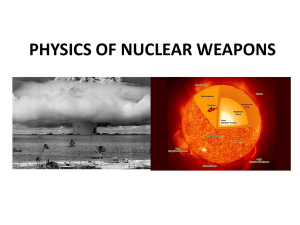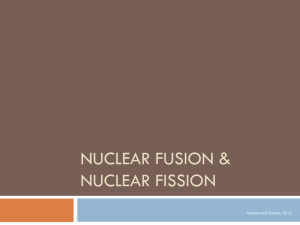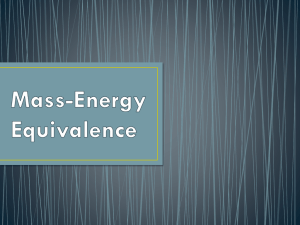Nuclear Fission and Fusion
advertisement
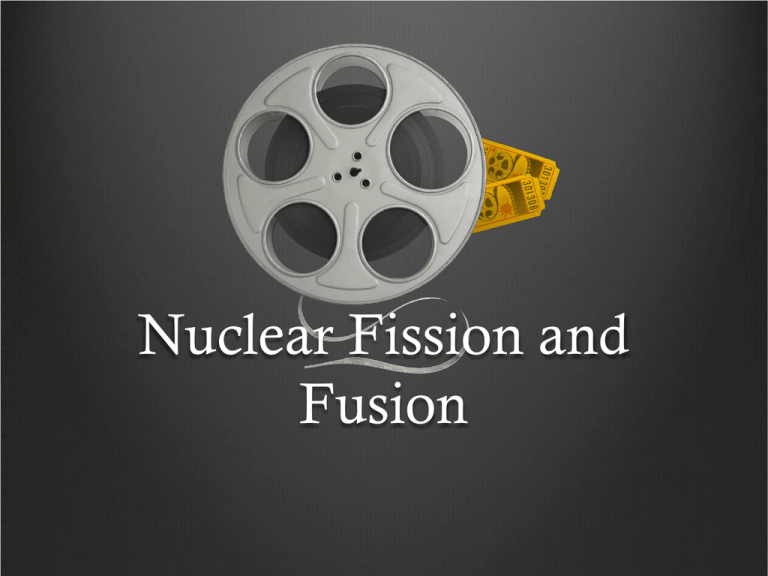
Nuclear Fission and Fusion Warm - Up What do you know, or think you know, about nuclear fission and fusion? Objectives Today I will be able to: Distinguish between different types of radiation with respect to their penetration power. Complete a Venn Diagram to compare and contrast nuclear fission and fusion. Review atom concepts to prepare for an exam Homework Study for the Atom Exam on Monday/ Tuesday of Next Week Keep working on data collection for STEM fair Agenda Warm – up Collect STEM introductions Review Gamma, Positron and Electron Capture Radioactivity Equation Practice Nuclear Chemistry Notes Fission vs. Fusion Venn Diagram Atom Exam Review Exit Ticket Radiation Alpha Beta Gamma Composition & Symbol Is shielded or stopped by? Radiation Composition & Symbol Alpha 2 p+ and 2 n0 Beta Stream of high speed e- Gamma Very high energy electromagnetic radiation Is shielded or stopped by? Shielding Radiation , aluminum Radiation Composition & Symbol Is shielded or stopped by? Alpha 2 p+ and 2 n0 paper Beta Stream of high speed e- Clothing, wood Gamma Very high energy Concrete, lead electromagnetic radiation Nuclear Fission A heavy nucleus splits into more stable nuclei of intermediate mass. Atomic Bombs Atomic bombs are an example of Fission Reactions. “Little boy” and “Fat man” were Atomic bombs made from fission reactions with uranium and plutonium respectively. A fission chain reaction is started and continues until the bomb destroys itself. Little Boy and Fat Man Nuclear Power Plants map: Nuclear Energy Institute Nuclear Power Plants Uranium-235 undergoes nuclear fission and releases thermal (heat) energy. This turns water to steam which spins turbines. The turbines produce electrical energy. Nuclear waste is fuel rods with unreacted uranium and radioactive products of fission. Right now this waste is buried in waste management facilities, like Yucca Mountain. Maryland Nuclear Power Plant Calvert Cliffs is Maryland’s nuclear power plant http://www.cleanenergyinsight.org/wp-content/uploads/2010/03/yuccamountain.jpg Nuclear Fusion Low-mass nuclei combine to form a heavier, more stable nucleus. Hydrogen Bombs Hydrogen bombs are an example of nuclear fusion. Two isotopes of hydrogen, 2H and 3H, fuse together and produce a lot of energy in the process. H-bombs release significantly more energy than atomic bombs. The Sun: Nuclear Fusion Sun + + 1 41H Four hydrogen nuclei (protons) 0 2 -1 e Two beta particles (electrons) 4 2 He + One helium nucleus Energy Nuclear Fission Nuclear Fusion Nuclear Fission A heavy atom splits into two or more lighter nuclei Ex: Atomic Bombs & Nuclear reactors Nuclear Fusion Release huge amounts of energy Produce nuclear waste High temp and pressure are used to combine light atoms to make heavier atoms Ex: Fuels the sun and stars & Hydrogen Bombs Comparing Fission and Fusion http://media-1.web.britannica.com/eb-media/03/72203-035-4D92BDBC.jpg Did You Know ? http://www.ambrosevideo.com/resources/documents/89.jpg The Next Slide The next slide shows a great flow diagram that links a lot of radioactive decay concepts. http://images4.wikia.nocookie.net/__cb20060611033960/schools/images/0/0b/Chart.JPG Exit Ticket

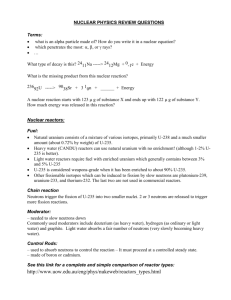

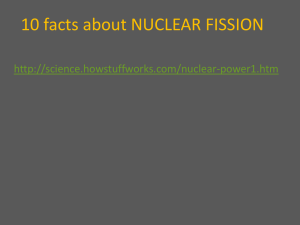

![The Politics of Protest [week 3]](http://s2.studylib.net/store/data/005229111_1-9491ac8e8d24cc184a2c9020ba192c97-300x300.png)

